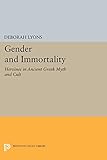Gender and Immortality : Heroines in Ancient Greek Myth and Cult / Deborah Lyons.
Material type: TextSeries: Princeton Legacy Library ; 345Publisher: Princeton, NJ : Princeton University Press, [2014]Copyright date: ©1997Edition: Course BookDescription: 1 online resource (290 p.) : 8 halftonesContent type:
TextSeries: Princeton Legacy Library ; 345Publisher: Princeton, NJ : Princeton University Press, [2014]Copyright date: ©1997Edition: Course BookDescription: 1 online resource (290 p.) : 8 halftonesContent type: - 9780691606217
- 9781400864386
- Greek literature -- History and criticism
- Greek literature -- History and criticism.;Women and literature -- Greece.;Immortality in literature.;Women -- Mythology -- Greece.;Sex role in literature.;Heroines in literature.;Mythology, Greek
- Heroines in literature
- Immortality in literature
- Mythology, Greek
- Sex role in literature
- Women -- Mythology -- Greece
- Women and literature -- Greece
- SOCIAL SCIENCE / Women's Studies
- online - DeGruyter
- Issued also in print.
| Item type | Current library | Call number | URL | Status | Notes | Barcode | |
|---|---|---|---|---|---|---|---|
 eBook
eBook
|
Biblioteca "Angelicum" Pont. Univ. S.Tommaso d'Aquino Nuvola online | online - DeGruyter (Browse shelf(Opens below)) | Online access | Not for loan (Accesso limitato) | Accesso per gli utenti autorizzati / Access for authorized users | (dgr)9781400864386 |
Browsing Biblioteca "Angelicum" Pont. Univ. S.Tommaso d'Aquino shelves, Shelving location: Nuvola online Close shelf browser (Hides shelf browser)

|

|

|

|

|

|

|
||
| online - DeGruyter The Elements of Social Theory / | online - DeGruyter Sympathetic Attractions : Magnetic Practices, Beliefs, and Symbolism in Eighteenth-Century England / | online - DeGruyter Rural Scenes and National Representation : Britain, 1815-1850 / | online - DeGruyter Gender and Immortality : Heroines in Ancient Greek Myth and Cult / | online - DeGruyter Luminaries : Princeton Faculty Remembered / | online - DeGruyter Masters of Bedlam : The Transformation of the Mad-Doctoring Trade / | online - DeGruyter Scholastic Magic : Ritual and Revelation in Early Jewish Mysticism / |
Frontmatter -- Contents -- Illustration -- Acknowledgments -- Note to the Reader -- Abbreviations -- Introduction -- Chapter One. Heroines and Heroes -- Chapter Two. Heroines and Mortals -- Chapter Three. Mortals and Immortals -- Chapter Four. Dionysiac Heroines -- Chapter Five. The Goddess and Her Doubles -- Appendix: Mythic Female Cult-Founders -- Conclusion -- Appendix . A Catalogue of Heroines -- Bibliography -- Index Locorum -- General Index -- ABOUT THE AUTHOR
restricted access online access with authorization star
http://purl.org/coar/access_right/c_16ec
In recent years, the topic of ancient Greek hero cult has been the focus of considerable discussion among classicists. Little attention, however, has been paid to female heroized figures. Here Deborah Lyons argues for the heroine as a distinct category in ancient Greek religious ideology and daily practice. The heroine, she believes, must be located within a network of relations between male and female, mortal and immortal. Using evidence ranging from Homeric epic to Attic vase painting to ancient travel writing, she attempts to re-integrate the feminine into our picture of Greek notions of the hero. According to Lyons, heroines differ from male heroes in several crucial ways, among which is the ability to cross the boundaries between mortal and immortal. She further shows that attention to heroines clarifies fundamental Greek ideas of mortal/immortal relationships.The book first discusses heroines both in relation to heroes and as a separate religious and mythic phenomenon. It examines the cultural meanings of heroines in ritual and representation, their use as examples for mortals, and their typical "biographies." The model of "ritual antagonism," in which two mythic figures represented as hostile share a cult, is ultimately modified through an exploration of the mythic correspondences between the god Dionysos and the heroines surrounding him, and through a rethinking of the relationship between Iphigeneia and Artemis. An appendix, which identifies more than five hundred heroines, rounds out this lively work.Originally published in 1997.The Princeton Legacy Library uses the latest print-on-demand technology to again make available previously out-of-print books from the distinguished backlist of Princeton University Press. These editions preserve the original texts of these important books while presenting them in durable paperback and hardcover editions. The goal of the Princeton Legacy Library is to vastly increase access to the rich scholarly heritage found in the thousands of books published by Princeton University Press since its founding in 1905.
Issued also in print.
Mode of access: Internet via World Wide Web.
In English.
Description based on online resource; title from PDF title page (publisher's Web site, viewed 30. Aug 2021)


